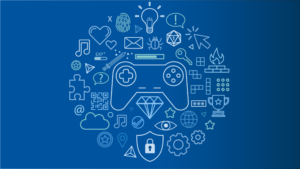When dealing with information technology, a whole range of dangers may lurk. In this context, the “human factor” is often presented as a particularly large and important challenge. Ignorance, naivety and a lack of caution are the most common causes of so-called insider threats. Experts agree on one thing: IT security can only be as good as the people who operate the systems.
For a security concept to be implemented successfully, it first has to be understood by the users. IT security awareness training courses are often used for this purpose. These are designed to strengthen the general understanding of security and to illustrate concrete risks. One of the most important strategies here is called gamification.
What is Gamification?
Gamification is the transfer of playful elements and mechanisms into a non-playful context. These elements are intended to promote motivation on the one hand, but also to encourage users to change their own behavior in certain situations. The gamification approach is based on the assumption that users have to complete certain tasks and achieve certain goals. These tasks are then rewarded, for example in the form of badges or points. These are then required, for example, to unlock new tasks. Users can also receive tips and tricks, have to find clues, answer quiz questions or solve puzzles in order to reach their goal.
However, it should not only be about disguising monotonous learning content and rewarding the performance of the users in an obtuse manner with points. Numerous video games succeed in conveying highly complex content and contexts to players. In order for the players to achieve their goal, this content and context have to be known and understood. Gamification therefore aims to find out how games convey complex content. On the basis of these findings, learning content can then be conveyed more adequately and meaningfully.
Possible Applications of Gamification
The approach of combining learning with playful elements is becoming increasingly popular and is being applied in more and more areas. We now encounter gamification strategies on a daily basis, both in teaching and in the world of work and leisure.
In many areas, companies are dependent on the knowledge of their employees always being up to date. E-learning is becoming increasingly popular in this context and offers enormous potential. Gamification is also becoming increasingly important in this context. Mandatory training courses, such as compliance training, can be lightened up and made more interesting with the help of gamification. Guidelines and technical content can be better communicated and internalized through interactive offerings.
How can Gamification Minimize Cyber Risks?
One of the underestimated components of IT security is still the security awareness of users. Many successful cyberattacks still start with the human factor. Regular education and training are therefore essential to promote IT security awareness. Here, immersive e-learning and simulations in particular show high success rates.
The benefits of game-based training offerings are numerous. For example, the learning experience can be tailored to the individual user through storytelling. Users can be confronted with typical procedural patterns of IT attacks in very concrete work situations. In this way, they learn in a playful way exactly how cybercriminals proceed and why. Employees can be effectively taught how to recognize attacks and how to behave. Internal company guidelines can also be clarified in this way.
If learners make the right decision, they are rewarded and can continue with the training. If, on the other hand, they make the wrong decision, the consequences of an attack can also be realistically simulated. The potential risks thus become much more comprehensible for each individual employee.
Learning content on compliance, data protection and IT security policies is often perceived as too dry, uninteresting or even too complex. Interactive learning platforms are designed to solve these problems. Complex content can be presented in a more comprehensible way. The game character and the associated entertainment factor also provide a welcome change in the often hectic daily work routine.
Users are also encouraged to interact with the material instead of just passively consuming it. During these interactions, they can apply learned content and may have to draw their own conclusions. Through the repetition of events and the increasing complexity of the tasks, the newly acquired knowledge can be additionally consolidated. Playful elements, such as collecting badges, also promote intrinsic motivation and are thus intended to encourage learners to learn in the long term. It also enables users to better assess their own level of knowledge and identify knowledge gaps themselves. An example of a game-based IT security training course can be found on the Fraunhofer Academy (Training in German only) website. There you can put your knowledge of IT security in the workplace to the test in a fun way in an Escape Room.
Gamification is therefore much more than just a nice gimmick. With well-founded methods from the psychology of learning, the motivation and willingness to learn of the users can be significantly increased even with supposedly uninteresting and complex topics. In this way, a sustainable transfer of knowledge can take place and the collective security awareness can be strengthened. Users learn to behave safely when using information technology and to recognize attempted attacks at an early stage. This is a fun way to effectively reduce the number of successful cyber attacks.
Want to learn more about IT security measures and risks? You can find all our articles on this topic under the tag IT security.
Responsible for the content of this article is Stéphanie Bauens.





